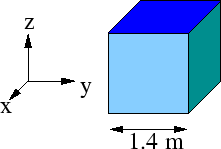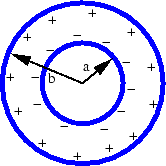


Next: Electric Potential
Up: Homework Problems for PHYS262,
Previous: Electric Fields
- 9-1
- A cube with 1.4 m edges is oriented as shown in Fig. 15
in a region of uniform electric field. Find the electric flux through
the right face if the electric field, in Newtons per Coulomb, is given
by (a)
 , (b)
, (b)  , and (c)
, and (c)
 .
(d) What is the total flux through the cube for
each of these fields?
.
(d) What is the total flux through the cube for
each of these fields?
Figure 15:
Prob 9-1
 |
- 9-2
- Figure 16 shows a section through two long
thin concentric cylinders of radii
 and
and  . The cylinders carry
equal and opposite charges per unit length
. The cylinders carry
equal and opposite charges per unit length  . Using Gauss'
Law, prove (a) that
. Using Gauss'
Law, prove (a) that  for
for  and (b) that between the
cylinders
and (b) that between the
cylinders  is given by
is given by
 .
.
Figure 16:
Prob 9-2
 |
- 9-3
- Two large metal plates of area
 face each
other. They are 5.0 cm apart and carry equal and opposite charges on
their inner surfaces. If
face each
other. They are 5.0 cm apart and carry equal and opposite charges on
their inner surfaces. If  between the plates is 55 N/C, what is
the charge on the plates? Neglect edge effects.
between the plates is 55 N/C, what is
the charge on the plates? Neglect edge effects.
- 9-4
- ``Gauss' Law for Gravitation'' is
where  is the enclosed mass and
is the enclosed mass and  is the universal gravitation
constant. Derive Newton's Law of Gravitation from this. What is the
significance of the minus sign?
is the universal gravitation
constant. Derive Newton's Law of Gravitation from this. What is the
significance of the minus sign?
- 9-5
- A charge of
 is at the centre of a cube of
side 80.0 cm. (a) Find the total flux through each face of the cube.
(b) Find the flux through the entire surface of the cube. (c) Would
your answers to parts (a) or (b) change if the charge were not at the
centre? Explain.
is at the centre of a cube of
side 80.0 cm. (a) Find the total flux through each face of the cube.
(b) Find the flux through the entire surface of the cube. (c) Would
your answers to parts (a) or (b) change if the charge were not at the
centre? Explain.
- 9-6
- A solid sphere of radius 40.0 cm has a total positive
charge of
 uniformly distributed throughout its
volume. Calculate the magnitude of the electric field (a) 0 cm, (b)
10.0 cm, (c) 40.0 cm and (d) 60.0 cm from the centre of the sphere.
uniformly distributed throughout its
volume. Calculate the magnitude of the electric field (a) 0 cm, (b)
10.0 cm, (c) 40.0 cm and (d) 60.0 cm from the centre of the sphere.
- 9-7
- A non-conducting wall carries a uniform charge density of
 . What is the electric field 7.00 cm in front
of the wall? Does your result change as the distance from the wall is
varied?
. What is the electric field 7.00 cm in front
of the wall? Does your result change as the distance from the wall is
varied?
- 9-8
- The starship Voyager travelling through an M-class
planet collides with trapped electrons. Since in space there is no
ground, the resulting charge build-up can become significant and can
damage electronic components, leading to control-circuit upsets and
operational anomalies. Model Voyager as a metallic sphere 0.3
km in diameter and assume that it accumulates 0.15 C of charge in one
orbital revolution. (a) Find the surface charge density. (b)
Calculate the resulting electric field just outside the surface of
Voyager.
- 9-9
- Two infinite, nonconducting sheets of charge are parallel
to each other. The sheet on the left has a uniform surface charge
density
 , and the one on the right has a uniform charge
density
, and the one on the right has a uniform charge
density  . Calculate the value of the electric field at
points (a) to the left of, (b) in between, and (c) to the right of the
two sheets.
. Calculate the value of the electric field at
points (a) to the left of, (b) in between, and (c) to the right of the
two sheets.



Next: Electric Potential
Up: Homework Problems for PHYS262,
Previous: Electric Fields
HJK
2001-07-22